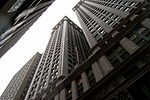American Surety Building

The American Surety Building (also known as the Bank of Tokyo Building or 100 Broadway) is an office building and early skyscraper at Pine Street and Broadway in the Financial District of Manhattan in New York City, across from Trinity Church. The building, designed in a Neo-Renaissance style by Bruce Price with a later expansion by Herman Lee Meader, is 388 feet (118 m) tall, with either 23 or 26 stories. It was one of Manhattan's first buildings with steel framing and curtain wall construction. The American Surety Building contains a facade of Maine granite. Its articulation consists of three horizontal sections similar to the components of a column, namely a base, shaft, and capital, making the American Surety Building one of the earliest New York City skyscrapers to feature such a layout. The facade contains several ornamental features, including sculptural elements designed by J. Massey Rhind. In addition, the American Surety Building uses an interior skeleton of structural steel, as well as a cantilevered steel structure for its foundations. The building was erected between 1894 and 1896 as a 21-story structure, which was the second tallest building in New York City when completed. Between 1920 and 1922, an annex was built to designs by Meader, increasing the floor area and adding two stories to the building. A later tenant, the Bank of Tokyo, hired Kajima International to restore the lower 13 stories between 1973 and 1975. The American Surety Building was made a New York City designated landmark in 1995.
Excerpt from the Wikipedia article American Surety Building (License: CC BY-SA 3.0, Authors, Images).American Surety Building
Broadway, New York Manhattan
Geographical coordinates (GPS) Address External links Nearby Places Show on map
Geographical coordinates (GPS)
| Latitude | Longitude |
|---|---|
| N 40.7081 ° | E -74.0112 ° |
Address
American Surety Building
Broadway 100
10005 New York, Manhattan
New York, United States
Open on Google Maps










